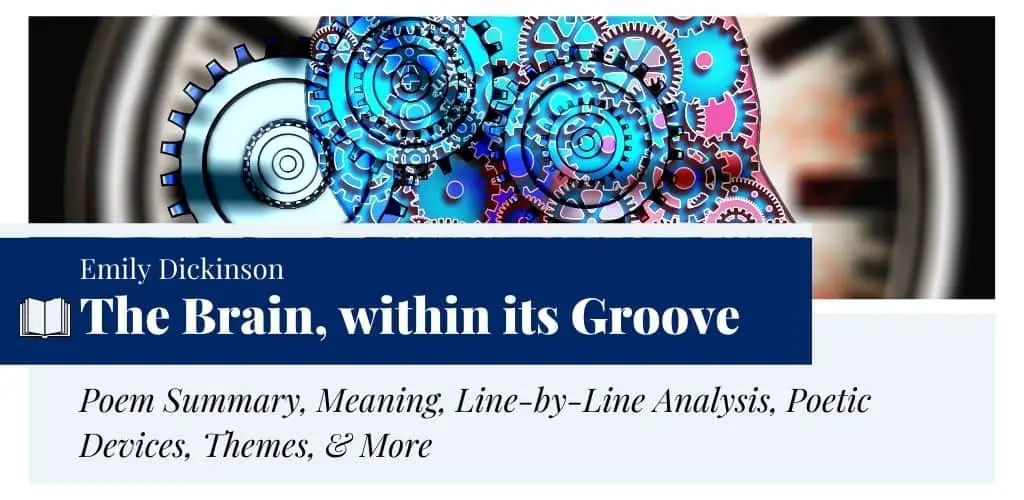The Brain, within its Groove by Emily Dickinson
Emily Dickinson’s “The Brain, within its Groove” is one of her poems on the brain. However, in this poem, the word “Brain” means mind or, more accurately, a train of thoughts. This piece, as per Dickinson’s writing style, this piece does not have a title. It was published as poem number 556 in The Complete Poems of Emily Dickinson (1955) by Thomas H. Johnson. The given title is borrowed from the first line of the poem.
The text has two versions, with slight differences in punctuation and words. In Poems (1890), Higginson and Todd swapped words for other choices – for instance, the original “trodden’” was replaced with the word “blotted” in the last line. They edited the first series of Dickinson’s Poems to finetune it to the standards of American writing in the 19th-century.
- Read the full text of “The Brain, within its Groove” below:
The Brain, within its Groove by Emily Dickinson The Brain, within its Groove Runs evenly—and true— But let a Splinter swerve— 'Twere easier for You— To put a Current back— When Floods have slit the Hills— And scooped a Turnpike for Themselves— And trodden out the Mills— - from The Complete Poems of Emily Dickinson (1955)

Summary
“The Brain, within its Groove”, at first glance, seems to say that the “Brain” is initially focused on a single train of thoughts. It “runs evenly” and “true” when it is focused on its desired path. However, a tiny “Splinter” can derail the “Brain” from its course and open the floodgates of various thoughts, including the painful and raging ones. Dickinson uses the word “Splinter” as a metaphor for a change or an impulse that can influence one’s mind. If a person fails to control the raging current induced by the impulse, it can scoop the “Turnpike,” another form of mental defense, and trod out the symbolic “Mills” where thoughts are processed.
Meaning
It is a short poem with multiple layers of meanings as Dickinson plays with the expectations of her readers. Her use of the word “Brain” means “a train of thoughts” or simply the human mind. She recourses to the biological image of the grooved brain because it is often used interchangeably with the mind. The moment it encounters a “Splinter,” there can be a cataclysmic shift in its activities; the train of thoughts is derailed, and it can no longer go back to focusing on a single predetermined destination or path.
The poem is rich in visual images of the water or “Current,” machines like “Turnpike” and “Mills” and that of “Floods.” While Dickinson describes the interruption to the thought process, she does not directly say whether it results in a creative or a catastrophic thing. This poem, like Dickinson’s poetry, is unconventional and experimental. It also refuses to remain in its “Groove” as readers come across a number of metaphysical conceits.
Form & Poetic Techniques
Form
“The Brain, within its Groove” is a short poem consisting of eight lines, divided into two quatrains. Emily Dickinson was known for her unconventional way of writing: her poems lacked perfect rhymes, were full of ambiguity and odd punctuations.
Rhyme Scheme
The poem does not follow a set rhyme scheme: the first quatrain follows the ABAB scheme and the second stanza follows the CDED. Lines 1 and 2 almost end with a similar rhyme called a slant rhyme. For instance, the terms “Groove” does not perfectly rhyme with “swerve” due to the presence of the “r” sound in the latter. The 6 and 8 lines in the second quatrain are in perfect rhyme, “Hills” and “Mills.”
Meter
The overall poem is composed of a regular meter that is the iambic trimeter. There is only one variation, and it occurs in the 7th line that is in iambic tetrameter. The shift of meter indicates a volta in the poem’s dynamics that aptly resembles the devastating impact of floodwaters. Let’s have a look at the scansion of the poem.
The Brain,/ wi-thin/ its Groove
Runs e/-ven-ly/—and true—
But let/ a Splin/-ter swerve—
‘Twere ea/-si-er/ for You—
To put/ a Cur/-rent back—
When Floods/ have slit/ the Hills—
And scooped/ a Turn/-pike for/ Them-selves—
And trod/-den out/ the Mills—
Poetic Techniques
Capitalization
In this poem, too, she uses several dashes and capitalizes the first letters of certain words such as “Brain,” “Groove,” “Splinter,” etc. The use of capitalization hints at stressing the words and guides the attention of the readers.
Metaphysical Conceits
The form of the poem reads almost like a flash flood. Dickinson begins the poem by using the metaphor of a train, only to abandon it later. She then uses the word “Splinter,” an unusual word choice as it does not relate to the conceit of the train. Finally, the last quatrain uses the conceit of “Floods” and is heavy in kinesthetic imagery. It’s almost like Dickinson wants to flood readers’ minds with complex ideas.
Use of Punctuation: Dashes
As a poet, Emily Dickinson’s style has been called idiosyncratic as it does not adhere to the poetics of conventional writing in the 19th-century. “The Brain, within its Groove” could thus be read as an embodiment of her unconventionality. Dickinson may not state outright, but her poem “swerve[s]” from its original thought.
The dashes seem to indicate a derailment in the train of thoughts, the “Splinter.” The first dash appears right after Dickinson writes, “The Brain, within its Groove/ Runs evenly—”, indicating a halt in the course caused by an unwelcome thought. This break eventually becomes a “Splinter,” so that Dickinson abandons the first two conceits in the second stanza.
Poetic Devices
Dickinson uses several poetic devices in “The Brain, within its Groove” in order to illustrate the theme. The important devices used in the poem include:
- Metaphor: In the first stanza, the “Groove” is a metaphor for the natural course of thoughts. People remain content with the thoughts that satisfy their hearts. According to the poet, “thoughts,” a train runs “evenly” on its desired “Groove.” However, a “Splinter,” a metaphor for an unwelcome thought, can derail the moving train of thoughts and open the floodgates for its kindred.
- Anaphora: Dickinson uses this device in the last two lines of the second stanza: “And scooped a Turnpike for Themselves—/ And trodden out the Mills—” The repetition of “And” at the beginning of these lines is meant for the sake of emphasis.
- Alliteration: This device is evident in “Splinter swerve.” Here, the repetition of the soft “s” sound creates a sibilance. It also hints at the nature of “Splinters” (an unwelcome thought) that silently changes the course of the thought-process of a person who fails to notice the modifier.
- Imagery: The poem is brimming with visual imagery of floods and machines like turnpikes and mills. Words like “Groove” and “Turnpike” establish the images in the readers’ minds. Dickinson also borrows the image of the grooved brain in human anatomy. Besides, she depicts a devastating current of flood in the second stanza. It is a use of kinesthetic imagery.
- Personification: “Floods” is given human characteristics as it is shown scooping out the turnpike to make way for entering into the land.
Line-by-Line Analysis & Explanation
Lines 1-4
The Brain, within its Groove
Runs evenly—and true—
But let a Splinter swerve—
‘Twere easier for You—
The first four lines of the poem establish Dickinson’s central idea. The poet writes that the “Brain” runs smoothly when it follows a particular train of thought. However, a sudden change in the form of a “Splinter” can irrevocably affect this train of thought. The use of the word “Splinter” hints at a fleck of an unwelcome thought.
“Splinter” usually has violent or unpleasant connotations. Using this term, Dickinson could imply that it is an unwelcome change or impulse that induces a chain reaction within the brain. It halts the usual train of thought. Similarly, Dickinson herself “swerve[s]” and changes the course of her ideas throughout the poem. The dashes signify sudden breaks in her thought process.
Lines 5-8
To put a Current back—
When Floods have slit the Hills—
And scooped a Turnpike for Themselves—
And trodden out the Mills—
The last quatrain is almost violent for its images. Dickinson depicts how the “Floods” slit the hills—a surgical and violent image in the second line. The “Turnpike” is scooped out of the earth, and it is now impossible to trace the direction of the original course of thought. It is bound to be affected by the splintery changes.
Continuing from the first stanza, Dickinson writes that it is easier to redirect the current of thought than to be unaffected by these changes. The last quatrain has an effect, almost like a flood in itself. The lines 5 to 7 of the poem keep increasing in their length, ending with dashes, depicting the uncontrollable flow of the current. In the last line, as the flood washes away the “Mills,” the line is shorter than the rest. In this way, Dickinson visually depicts a tumultuous flood in order to compare it to the ravaging impact of unleashed thoughts.
Theme
Change
The theme of “The Brain, within its Groove” boils down to the impact of change in thought patterns. Readers could find this change to be either positive or negative, as Dickinson describes in her poem. However, when compared to her poems like “I dwell in Possibility –”, one can assume that this poem regards change as necessary. This turn in the thought process will eventually open up more possibilities.
In 19th-century America, during Dickinson’s lifetime, several changes occurred simultaneously, such as industrialization. There was rapid growth, and people were relying more on technology. Dickinson probably referred to this socio-economic change in her poem, as hinted by the use of mechanical conceits. From her tone, it can be assumed that she is not skeptical of this change.
Lack of Control
Another critical theme tied to this piece is the lack of control while encountering a change. Dickinson suggests a lack of control, as a social change often brings and compares it to losing control over one’s thoughts. This is established by the use of flood imagery. According to the poet, it is impossible to control a flood if a “Splinter” causes damage to a floodgate. The flood trods out the turnpike that was holding it back and forcefully topples gigantic mills. The change it brings is indeed unwelcome.
Dickinson also wrote, “The Brain—is wider than the Sky—” that is all about the capacity of the human mind. Therefore it can be argued that she thinks that even if the change has a positive or negative influence on the mind, it is a necessary evil that helps broaden the mind’s limit.
Historical Context
Emily Dickinson’s “The Brain, within its Groove” was first published in 1890 in her posthumous collection Poems, edited by M. L. Todd and T. W. Higginson. Emily Dickinson gained popularity posthumously, and the Todd and Higginson collection went for three editions. The poems in this collection, despite Todd’s claims, were heavily edited to fit into the mold of 19th-century American poetry. This is evident from the lack of capitalization and dashes – two trademarks of Dickinson’s poetry. The 1890 edition deliberately replaces certain words.
It was in 1955 that Thomas H. Johnson published The Complete Poems of Emily Dickinson. This edition included the original punctuation used by Dickinson as Johnson wanted to be genuine to the poet. He did not give titles to the poems like the poet. Instead, he numbered them according to the period of their composition.
Every poet is a product of their time, and Dickinson is no exception. Her style may be unconventional, but her poems often reflect the American milieu in the 19th-century. Compared to her peers, Emily Dickinson was well-educated and thus had studied Calvin Cutter’s study on the brain. According to Cutter, the brain was “the organ of the mind.” The function of the brain was to control the rest of the body.
This makes for an interesting footnote for the poem, where Dickinson “swerve[s]” (line 3) out of control. The use of the train track (“Groove”) and the “Mills” as conceits suggests the impact of industrialization on society, culture, and economy. Emily was interested in the cerebrum—she often uses it in her poems, as evident in her probing lyric “The Brain, within its Groove.”
Questions & Answers
Emily Dickinson is known for the capitalization of words, mainly nouns. It helps Dickinson to stress certain words, like the “brain” and “groove” in “The Brain, within its Groove.” Dickinson also knew German, where nouns are usually capitalized. By doing this, Dickinson also developed a characteristic style of hers, regarded as unique and peculiar in 19th-century American poetry.
Emily Dickinson was known for her extensive use of dashes in poetry. She used dashes not just in her poems but also in writing down recipes or copying poems by other poets. This style was not exclusive to Dickinson, but she was the only one who used it in her poems. In “The Brain, within its Groove,” Dickinson uses dashes to signify a break/halt in her train of thoughts. She also ends the poem with a dash, which can be interpreted as incomplete. Perhaps she wanted to show that her course of thoughts was yet again interrupted.
In this poem, Dickinson writes that the mind, when following a particular course of thought, runs smoothly. However, a “Splinter” or a sudden change can affect the flow and start another catastrophic chain reaction resembling the floodwater breaking the floodgates, scooping the “Turnpike,” and trodding out the “Mills.”
The speaker of the poem is none other than the poet Emily Dickinson. She writes this piece from the second-person point of view and directly addresses the readers.
Emily Dickinson uses two major metaphors in the poem – that of a train and “Splinter.” The use of these conceits describes how a splintery, unwelcome thought influences one’s thought process. In the second stanza, “Turnpike” and “Mills” denote the impact of industrialization in 19th-century American society. Dickinson borrows the train imagery from the phrase “train of thought,” which is controlled by the “Brain,” synonymous with the human mind in this poem.
This line marks a shift in Dickinson’s “The Brain, within its Groove.” Through this line, the poet signifies that a simple “Splinter,” a metaphor for an unwelcome thought, causes to change the direction of one’s thought process abruptly. Then, it becomes hard to hold the other “Current” of thoughts back.
Similar Poems about the Human Mind
- “Have you got a brook in your little heart” by Emily Dickinson — This Dickinson poem is about the human heart compared to a brook.
- “Journey to the Interior” by Margaret Atwood — This poem describes the poet’s metaphorical journey into her mind.
- “Spring” by Edna St. Vincent Millay — In this poem, Millay captures how the coming of spring induces her mind.
- “One’s Self I Sing” by Walt Whitman — This poem celebrates the unique “self” or the human mind.
External Resources
- Discussion on Dickinson’s “The Brain, within its Groove” — Watch this informative discussion on different connotations of the poem.
- Original Manuscript of “The Brain, within its Groove” — Explore the original handwritten manuscript of the poem.
- Different Versions of “The Brain, within its Groove” — Check out two slightly different versions of the poem published in 1890 and 1955, respectively.
- Dickinson’s Town & Times — Read about the poet’s town and her surroundings.
- Significant Characteristics of Emily Dickinson’s Poetry — Learn about the unique poetic styles of Dickinson.
- About Emily Dickinson — Learn about the poet’s life and explore some of her best-known poems.






